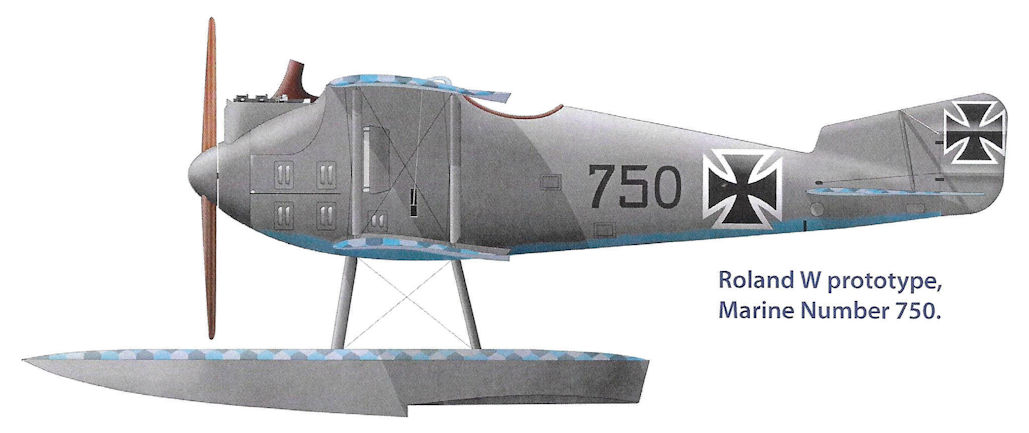O.Thetford, P.Gray German Aircraft of the First World War (Putnam)
L.F.G. WD
This single-seat seaplane was developed from the D I and intended as a station defence machine. It first flew on 29th June 1917 and remained a solitary prototype. Engine, 160 h.p. Mercedes D III.
W.Green, G.Swanborough The Complete Book of Fighters
LFG ROLAND W Germany
The Roland W twin-float fighter seaplane was an adaptation of the D I. Flown for the first time on 29 June 1917, and powered by a 160 hp Mercedes D III engine, it arrived for evaluation at the base of the Seeflugzeug-Versuchs-Kommando (SVK) at Warnemunde in the following month. It was promptly returned to LFG for modifications aimed at improving the flying characteristics and the view from the cockpit. It was returned to the SVK in September 1917, modified once more and then flight tested, but the poor visibility it offered the pilot led to its prompt rejection. The sole prototype, after further modification to the fuselage, was assigned to the marine single-seat fighter school in November 1917.
Time to 3,280 ft (1 000 m), 5.4 min.
Empty weight, 2,531 lb (1148 kg).
Span, 33 ft 1 2/3 in (10,10 m).
Length, 29 ft 4 1/3 in (8,95 m).
Height, 10 ft 5 7/8 in (3,20 m).
J.Herris Roland Aircraft of WWI (A Centennial Perspective on Great War Airplanes 9)
Roland W
The Roland W, Marine number 750, was developed from the operational Roland D.I fighter, itself derived from the successful Roland C.II. Compared to the D.I the W had enlarged wings to carry the additional weight of the floats and carried only one machine gun. The vertical tail surfaces were enlarged from the D.I to compensate for the side area of the floats forward of the center of gravity. Like the C.II and D.I, the W was powered by a 160 hp Mercedes D.III.
The W was flown from the Roland seaplane factory at Stralsund to the SVK test center at Warnemunde on June 29, 1917 for evaluation. On August 15 the SVK reported that the flight characteristics and pilot's visibility were very bad, and the W was returned to Stralsund for modification. By September 15 it was back at the SVK. After re-testing in late September, the SVK reported that flight characteristics had not improved. The type was dismissed as a fighter and the two other prototypes ordered were cancelled and their Marine numbers (789 and 790) were re-assigned. The production orders for single-seat floatplane fighters went to the more docile and maneuverable Rumpler 6B1 along with the Albatros W4 and Brandenburg KDW. The sole Roland W was purchased as a trainer on November 1, 1917, and assigned to the naval Einsitzerschule (single-seat fighter school) at Hage, where it was found by the Allies in December 1918.
Roland W Specifications
Engine: 160 hp Mercedes D.III
Wing: Span Upper 10.10 m
Span Lower 9.70 m
Chord Upper 1.65 m
Chord Lower 1.65 m
Gap 1.50 m
Area 29.9 m2
General: Length 8.95 m
Height 3.20 m
Empty Weight 868 kg
Loaded Weight 1148 kg
Climb: 1000m 5.4 min
2000m 12.7 min
J.Herris German Seaplane Fighters of WWI (A Centennial Perspective on Great War Airplanes 2)
Roland W
The Roland W, Marine #750, was derived from the operational Roland C.II two-seater. Like the C.II, the W was powered by a 160 hp Mercedes D.III and mounted a single fixed machine gun, but other details are not known and no production was undertaken.
The Roland C.II was more noted for its speed than its good handling qualities, and it is likely the similar Roland W did not excel in handling either, with the result the production order went to the more docile and maneuverable Rumpler 6B1.
 |
J.Herris - Roland Aircraft of WWI /Centennial Perspective/ (9)
|
| Roland W prototype, Marine Number 750.
|
 |
J.Herris - Roland Aircraft of WWI /Centennial Perspective/ (9)
|
Предпринималась попытка установить Роланд DI на поплавки, однако маломощный двигатель не позволил получить требуемые характеристики.
The Roland W photographed at the L.F.G. factory.
|
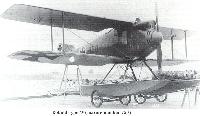 |
Сайт - Pilots-and-planes /WWW/
|
| The Roland W was a twin-float seaplane adaptation of the D I, remaining a prototype.
|
 |
J.Herris - German Seaplane Fighters of WWI /Centennial Perspective/ (2)
|
| The Roland W photographed at the SVK Warnemunde.
|
 |
J.Herris - Roland Aircraft of WWI /Centennial Perspective/ (9)
|
| Except for its ear radiators, the Roland W was nicely streamlined. It used the Wickelrumpf technology of fuselage construction, narrow ribbons of wood wrapped around a mold and glued into a strong, light-weight shell that was streamlined and resistant to combat damage. Wickelrumpf was pioneered by L.F.G. and later used successfully by Pfalz.
|
 |
J.Herris - German Seaplane Fighters of WWI /Centennial Perspective/ (2)
|
| Except for its ear radiators, the Roland W was nicely streamlined, it used the Wickelrumpf technology of fuselage construction, narrow ribbons of wood wrapped around a mold and glued into a strong, light-weight shell that was streamlined and resistant to combat damage. Wickelrumpf was pioneered by L.F.G. and later used successfully by Pfalz.
|
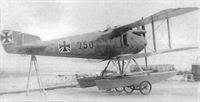 |
J.Herris - Roland Aircraft of WWI /Centennial Perspective/ (9)
|
| The Roland W, Marine #750, was derived from the Roland C.II two-seat reconnaissance airplane. Only one prototype was built. It was powered by the same 160 hp Mercedes D.III engine used in their C.II.
|
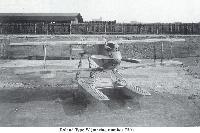 |
Сайт - Pilots-and-planes /WWW/
|
| Roland Type W (marine number 750)
|
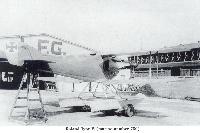 |
Сайт - Pilots-and-planes /WWW/
|
| Roland Type W (marine number 750)
|
 |
J.Herris - Roland Aircraft of WWI /Centennial Perspective/ (9)
|
|
|

